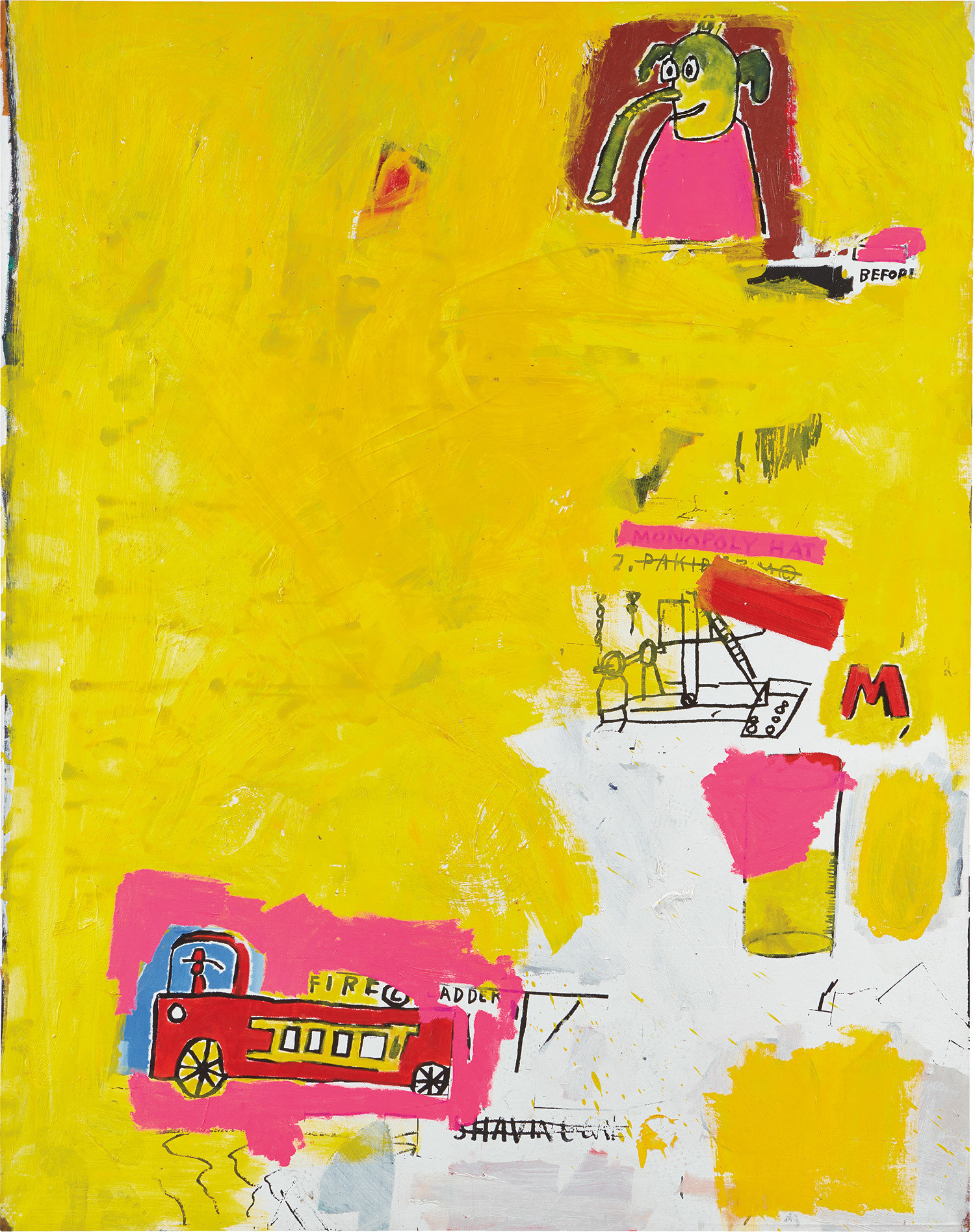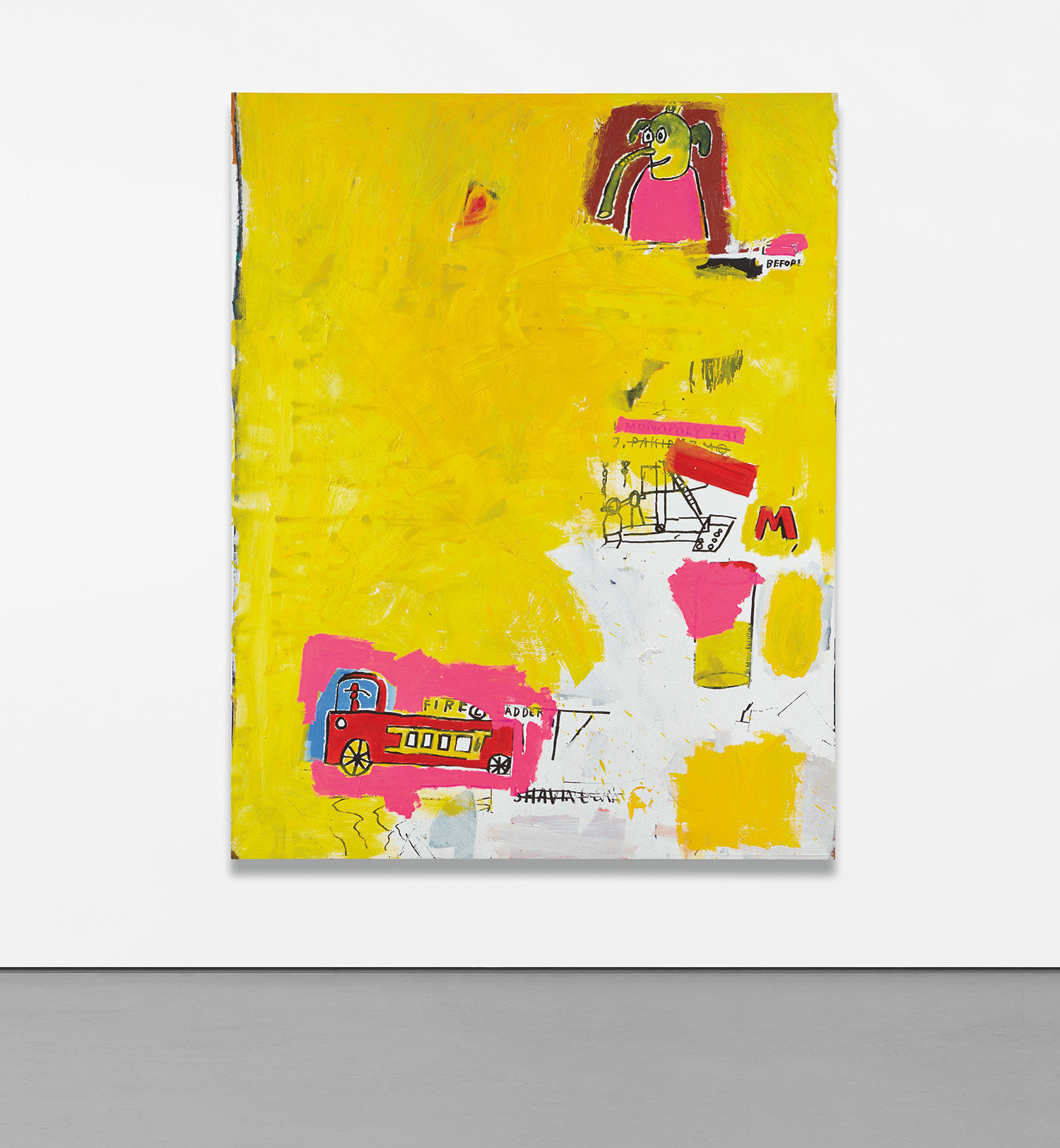



21
Jean-Michel Basquiat
Pink Elephant with Fire Engine
Full-Cataloguing
True to Basquiat’s distinct vernacular, spanning drawings, writing, and an erratic painterly approach deployed with childlike candour, Pink Elephant with Fire Engine merges the visual languages of nature and the city, through the layering of three distinct chromatic tones. Commanded by its prevailing solar hue, the present work is additionally punctuated by interspersed pigments of arid red and fiery pink, together animating the overall surface and conveying the heat of the environments suggested at the heart of the composition. As an ensemble, they summon the colours radiated under the sun of two jungles: one literal, populated by wild animals in faraway lands, and one figurative, designated by New York City's infamous epiteth, a jungle of its own. Notably, Pink Elephant with Fire Engine captures the impressions Basquiat is able to produce through the use of colour: irrepressible dynamism and infectious liveliness. As it stretches over two metres in height, the painting furthermore summons an arresting physical presence that only vivifies its pure, roaring energy.
Pink Elephant with Fire Engine addresses a number of themes that have concerned Basquiat during his all-too-short career. Most strikingly exposing the artist’s take on displacement and duality, the painting juxtaposes an essentially abstract background with loosely rendered figurative signs. On the one hand, the composition conveys the archetypical noise of New York City’s busy streets through one of its two titular protagonists: the fire engine, which, in conjunction with its constitutive sirens, bears immediate associations to the boisterous fervour of downtown Manhattan. At the same time, the artist mobilises references that are geographically distant, through the mystifying presence of a pink elephant in the top right quadrant of the present work. Smiling wide under its tubular trunk, Basquiat’s elephant bears cartoonish features that liken it to an enigmatically anthropomorphic figure. The thematic fragmentation contained within Pink Elephant with Fire Engine reflects the duality that Basquiat continuously negotiated throughout his life, manifested in the twofold cultural legacy he inherited from his parents, and the amalgamation of his conflicting personas in later years: a subversive artist exploiting urban landscape on the one hand, and a successful painter attending to the lifestyle of New York’s creative elite on the other.
Born to a Haitian father and a Brooklyn-based mother of Puerto Rican descent, Basquiat remained close to the city of New York throughout his life, with frequent travels to Los Angeles and Hawaii. In March 1984, Basquiat had just returned from the island of Mauii to organise his very first solo exhibition with the art dealer Mary Boone. During that year, Boone had become Basquiat’s new primary dealer alongside Bruno Bischofberger, and she had, in spring, selected Pink Elephant with Fire Engine as part of the artist’s inaugural show at her gallery. Open throughout the month of May in 1984, Basquiat’s show at Mary Boone collected an array of positive reviews, including Vivien Raynor’s prestigious celebration of the painter’s work in The New York Times. ‘The young artist uses color well’, she wrote. ‘But more remarkable is the educated quality of his line and the stateliness of his compositions, both of which bespeak a formal training that, in fact, he never had’ (Vivien Raynor, ‘Art: Paintings by Jean-Michel Basquiat at Boone’, The New York Times, 11 May 1984, online). At the mere age of 24, Basquiat impressed contemporary art critics with his natural flair, and cemented his status as New York’s ‘Radiant Child’ – one that had been coined by Rene Ricard in the American poet’s seminal Artforum article of 1981. Just a few months following the creation of Pink Elephant with Fire Engine, Basquiat was notably bestowed his first ever solo exhibition in a museum, at the Fruitmarket Gallery, Edinburgh, which later travelled to the Institute of Contemporary Art in London.
Heavily influenced by his urban surroundings and his involvement with the culture of downtown Manhattan in the late 1970s and early 1980s, Basquiat often allowed external interests and elements to glide into his compositions. ‘The way he lived was all part of the work, and the work was part of his life’ (Fred Brathwaite, a.k.a Fab 5 Freddy, Interview, October 1992, reprinted in Jean-Michel Basquiat, exh. cat., Serpentine Gallery, London, 1996). As a result, Pink Elephant with Fire Engine not only mirrors the energy of New York's bustling cultural scene, but also conflates a number of the artist’s most revered artistic tropes and idiosyncrasies.
Brimming with chromatic vigour and presenting a spontaneous, gestural style throughout, Pink Elephant with Fire Engine culls from a variety of imagistic sources that Basquiat instinctively pulled from throughout his career. The reference to the practice of graffiti that Basquiat lent himself to in his early years is evident in the thinly delineated black drawings at the centre of the composition, as well as the elephant and engine’s idiosyncratically simple appearance. The composition’s rhythm, ruled by a deliberate placement of incongruous elements on canvas, further forms a visual cadence akin to instinctive and visceral melodies; as such, it denotes the artist’s obsession with jazz music which he repeatedly included in his painterly compositions. Illustrating Glenn O’Brienn’s statement that, ‘[Basquiat] ate up every image, every word, every bit of data that appeared in front of him, and he processed it all into a bebop Cubist Pop Art cartoon gospel that synthesized the whole overload we lived under into something that made astonishing new sense’, Pink Elephant with Fire Engine displays an array of references that mirrors elements from both the outside world and Basquiat’s explosive imagination (Glenn O’Brien, ‘Greatest Hits’, Jean-Michel Basquiat: Now’s the Time, exh. cat., Art Gallery of Ontario, Toronto, 2015, p. 177).
Instead of emulating elements that surround him with a realist hand and clear narratorial conviction, Basquiat employs a youthful gesture that conveys a scene’s life through synaesthetic impression rather than visual verisimilitude. Following an irrepressibly instinctive beat that is typical of the dynamic environment he kept alive in his feverishly energetic studio, Basquiat organically reveals the varying stages of his painting’s completion, like a perpetually astonished child documenting his discoveries. The result is a prodigiously raw canvas boasting uneven fillings, emblematic of the experimental methods that the artist introduced to the medium. ‘I start a picture and I finish it’, declared the artist. ‘I don’t think about art while I work. I try to think about life’ (Jean-Michel Basquiat, quoted in Leonhard Emmerling, Basquiat, Berlin, 2006, p. 75). Revealing the painterly progression that constitutes the painting’s creation, the present work is a corporeal manifestation which invites the viewer to witness its multiple stages of gestation.
A brilliant study in colour and symbolic ambiguity, Pink Elephant with Fire Engine exudes the thrilling vigour of pictorial chaos. It shares the same whimsical animalistic reference as Basquiat’s painting Pakiderm, 1984, and a number of other paintings where the artist included the symbol of the elephant in varying scales. Eponymously reinventing the spelling of the word pachyderm, which defines an antiquated order of nonruminant mammals, the titular painting delineates the contour of a Dumbo-like elephant, echoing the childlike rendition of the wild animal crowning the present composition. Yet in Pink Elephant with Fire Engine, a multitude of additional elements eschew the realm of wilderness: a fire-engine, the letter M, and an enigmatic reference to Monopoly, struck through with a diaphanous wash of pink paint. ‘I cross out words so you will see them more’, the artist mused. ‘The fact that they are obscured makes you want to read them’ (Jean-Michel Basquiat, quoted in Richard Marshall, ed., Jean-Michel Basquiat, New York, 1992, pp. 28-43). Tentatively interrupting the background’s monochromatic expanse, these added characters and graffiti-like compositions irreverently impose their presence on the painting’s surface.
Adorning a number of Basquiat’s most important paintings and creative manifestations, the colour yellow proved to be a recurrent force in the artist’s opus. Pervading the surface of Hollywood Africans, 1983, residing in the Whitney Museum of Art, New York, the heliacal colour furthermore served as a stark chromatic ground for Tony Shafrazi and Bruno Bischofberger’s Collaborations Exhibition poster, 1985, starring Andy Warhol and Basquiat in their infamous boxing attire. Recurring objects and themes in Basquiat’s visual syntax include bananas, pollo fritto, and New York taxis – all common in tying their signs back to the same constitutive hue, here covering almost the entirety of the canvas. Unlike his works saturated with symbols and figures in a manner akin to Jackson Pollock’s all-over compositions, Pink Elephant with Fire Engine exudes a composed aura deriving from its essential subject matter. It demonstrates the influence that the American Abstract Expressionists and colourists had on his painterly approach, particularly with regards to his mastery of tonal contrast. With a diminished palette of yellow-pink-red that conjures temperature more than it does imagery, Pink Elephant with Fire Engine aligns with an abstract tradition of sentience over perception.
Jean-Michel Basquiat
American | B. 1960 D. 1988One of the most famous American artists of all time, Jean-Michel Basquiat first gained notoriety as a subversive graffiti-artist and street poet in the late 1970s. Operating under the pseudonym SAMO, he emblazoned the abandoned walls of the city with his unique blend of enigmatic symbols, icons and aphorisms. A voracious autodidact, by 1980, at 22-years of age, Basquiat began to direct his extraordinary talent towards painting and drawing. His powerful works brilliantly captured the zeitgeist of the 1980s New York underground scene and catapulted Basquiat on a dizzying meteoric ascent to international stardom that would only be put to a halt by his untimely death in 1988.
Basquiat's iconoclastic oeuvre revolves around the human figure. Exploiting the creative potential of free association and past experience, he created deeply personal, often autobiographical, images by drawing liberally from such disparate fields as urban street culture, music, poetry, Christian iconography, African-American and Aztec cultural histories and a broad range of art historical sources.